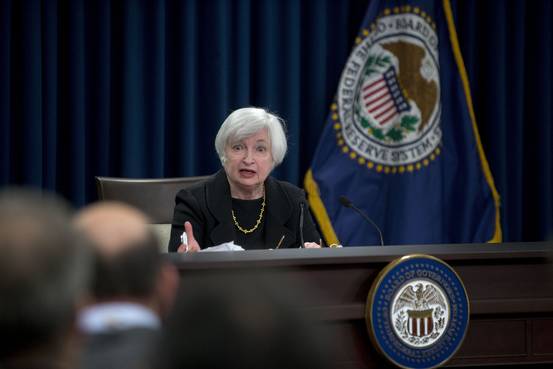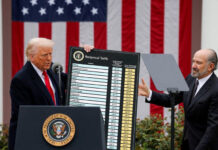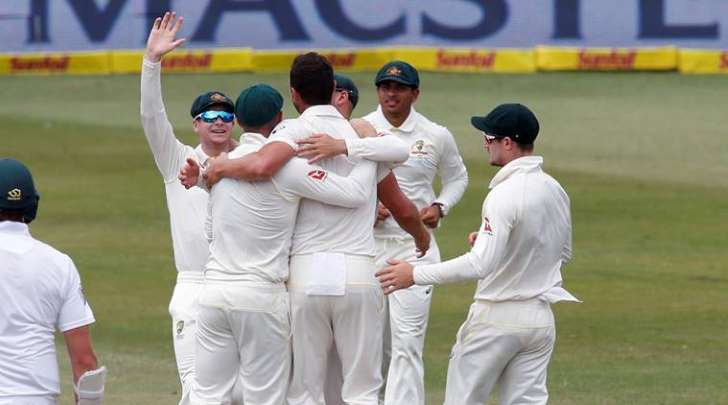September 17, 2015
WASHINGTON, DC: Sometime this year, the Federal Reserve is likely to do something it hasn't done in nearly 10 years: raise interest rates. The decision, which could come as soon as Thursday afternoon, sounds wonky, but it is momentous for the nation's economy.

September 17, 2015
WASHINGTON, DC: Sometime this year, the Federal Reserve is likely to do something it hasn't done in nearly 10 years: raise interest rates. The decision, which could come as soon as Thursday afternoon, sounds wonky, but it is momentous for the nation's economy.

- Janet Yellen, chairwoman of the Federal Reserve, speaks during her news conference on Thursday.
Whether the Fed acts Thursday or later this year, as many expect, hiking rates would mark the end of an historic effort to lift growth and create jobs – an effort that has had decidedly mixed results. Unemployment is down, but workers aren't getting meaningful raises, and there's still a general sense that the economy isn't as strong as it could be.
When the Fed does move to raise interest rates, the cost of all sorts of other loans, from mortgages to credit cards, will likely also go up. Lending is the lifeblood of the economy, so any change could affect not just the price to borrow but the stock market, the jobs market and the value of the dollar. It will also mark a new chapter in the nation's economy, and a sign that nation's economic stewards believe it is relatively safe from the risk of a sudden downturn. Not everyone agrees, however.
Understanding what the Fed is, and why the Fed does what it does, can be pretty complex. Here's what you need to know.
What does the Fed need to decide now?
The Fed controls a benchmark interest rate, known as the fed funds rate, and it needs to decide whether to raise interest rates or stay put. Officials, led by Fed Chair Janet Yellen, say they're prepared to raise rates this year. But it’s a tough call when that will happen.
The Fed will wrap up a two-day policy meeting in Washington on Thursday. Just a few months ago, many analysts and investors expected it would end with an announcement that the central bank is raising its benchmark interest rate for the first time in nearly a decade. The Fed originally reduced interest rates all the way to zero during the financial crisis, and it has not lifted them since. But some worry that extraordinary approach – which makes borrowing super-cheap — has outlived its usefulness, and created new risks.
Recently, though, the timeline to raise rates was thrown into doubt. Global financial markets have been on a roller coaster – remember that 1,000-point drop in the Dow Jones industrial average? just last month – while fears are growing that the world economy, led by China, is slowing down.
Here in the U.S., workers aren't getting raises and prices on goods and services are rising slowly, both facts that suggest that the economy really isn't revving on all cylinders.
Wait, back up. What exactly does the Fed do again?
The Fed is the nation’s central bank. It does a lot of things, all with the goal of making sure the economy is healthy. What does healthy mean? Growing at a decent pace, roughly three percent per year, with jobs for everyone who wants one, with incomes rising and the cost of goods and services stable.
It has a few ways of trying to achieve that balance, but arguably the most important is setting a target for the interest rate that banks pay to borrow money from each other overnight — the fed funds rate. It’s one of the least risky loans of all, so it essentially sets the basis for all other borrowing across the country.
It seems like a simple thing, but decades of economic analysis and experience show that that simple thing has enormous power over economy.
But how does the Fed affect me on a daily basis?
Well, ultimately, a good economy can help decide whether you have a job, or a good job, that pays enough so you can afford what you need to live a happy life.
In the short term, when the Fed raises its target rate, interest rates on everything from mortgages to car loans to factory equipment generally go up as well. And when the Fed lowers the target rate, borrowing gets cheaper. Because the Fed cut its rate to zero, you can get mortgage loans these days for 4 percent or auto loans at no cost. (Just don't tell your parents or grandparents, who will remember having paid in the double-digits for a loan.)
If you doubt the central bank’s influence over your wallet, just look at what happened in 2013. Then-Fed Chair Ben Bernanke merely hinted that he might be ready to slow the Fed's efforts to boost the economy. Markets panicked, and interest rates spiked across the board.
Mortgage rates for a 30-year fixed-rate loan went from an average of 3.41 percent in January to 4.46 percent by the end of the year – a full percentage point jump. Imagine buying a single-family home that year at the median price of $197,400, with a 20 percent down payment. The jump in interest rates translates into an extra $95 a month – and $34,267 over the life of the loan.
Tell me more about Janet Yellen. Does she play the same role as Ben Bernanke and Alan Greenspan?
Janet Yellen is the chair of the Fed, taking over the post last year from Bernanke before her and Greenspan before him. (Side note: She's the first woman to ever hold the position.) She's pretty close philosophically to Bernanke and served as vice chair during his tenure.
Yellen believes that the Fed can play in helping the economy return to normal. She is a staunch supporter of the massive stimulus the Fed unleashed under Bernanke to help the country avoid another Great Depression. She is less worried about prices spiraling out of control and more worried about the number of people who are unemployed or underemployed. In the wonky world of Fed watchers, that makes her a "dove" — as opposed to a hawk who is more worried about inflation.
What’s the case for raising the fed funds rate now?
Higher rates in a stronger economy is part of the natural order of the world. But timing is everything: Move too soon, and the Fed could undermine the recovery’s momentum. If people can't get affordable loans, they can't invest in new hires or new equipment or new houses.
But move too late, and it risks allowing the economy to overheat, causing stock market bubbles or the type of inflation that you sometimes see in other countries, where prices are going up so fast that people's incomes have trouble keeping pace.
The Fed tries to balance these two concerns, pushing the jobless rate as low as possible while also ensuring that prices don’t rise too quickly or too high.
Those who think it’s time for the fed funds rate to rise are generally worried that the central bank is risking too much inflation. They make two arguments.
The first points to the unemployment rate for justification. The national jobless rate was 5.1 percent in August, down from a high of 10 percent just after the recession and close to what many economists believe is its lowest sustainable level. They argue low unemployment is a sign that the economy is heating up so much that businesses and consumers start spending more freely. That allows companies to charge more for their products, which in turn encourages workers to demand higher wages and inflation starts to rise.
Because monetary policy operates with long lags, any action by the Fed now could take a year or more to filter through to the economy. Dallas Fed President Richard Fisher, king of metaphors, likened monetary policy to duck hunting: Shoot where the duck is going, not where it’s been. So if it acts now, the Fed could avoid overheating later on.
The second argument is that so many years of easy money are creating dangerous risks for the economy. The (until recently) record highs in stock markets, the record low yields in bond markets, even the long-awaited but now substantial rise in housing prices — all have been labeled with the dreaded b-word: bubble. So according to this thinking, the Fed should raise rates to reduce the incentives for investors to make risky bets.
Sounds scary. Why would anyone want them to wait?
Despite what some of the statistics suggest, it’s not really so clear that the economy — and more precisely, the jobs market — is really as strong as it seems. Even though the unemployment rate is 5.1 percent, there’s a large shadow workforce that isn’t reflected in that number. They include people who have gotten discouraged about their job prospects and dropped out of the labor market. Others are working part-time but would really like full-time jobs. Even those with full-time jobs may have settled for positions that don’t use all of their skills.
Wage growth, meanwhile, has been stuck at about 2 percent for years, well below the 3 to 4 percent average of previous decades.
That argument hits a nerve with Yellen, who is a labor economist by training and has frequently cited these issues as signs of underlying weakness in the labor market. If the job market is not really as strong as the unemployment rate suggests, inflation is probably farther off — and the Fed can afford to wait longer before making a move.
The Fed has set a 2 percent target for inflation, and right now price changes are running well below that. In fact, inflation is so low that some prominent economists think it’s a sign that the Fed ought to be doing more to stimulate the recovery.
Then there’s China. Fears are mounting that the world’s second-largest economy is slowing down — and that political leaders have run out of tools or the political will to prop it back up. That’s what set off the recent bout of gut-wrenching swings in markets around the world.
Financial conditions in the U.S. now appear more precarious than they were just a few weeks ago, and experts say that nervousness about a potential increase in interest rate have already made investors behave as though one had already happened.
As a result, the downside to delaying for a few weeks or months may be relatively small. But the costs of moving too soon – a spike in mortgage rates that chokes off the housing market, a dramatic decline in financial markets, and another recession – could be much higher.
If the Fed doesn’t raise rates now, when might it make a decision?
The Fed’s top officials hold a policy-setting meeting every six weeks. They have two more meetings this year, in October and December. So theoretically, they have two more chances in 2015 to revisit the issue.
Here’s the catch: The Fed chair holds a press conference after every other meeting. Many analysts believe the central bank is unlikely to take such a major step without giving Yellen a chance to explain why afterward. A press conference provides the perfect opportunity. There’s one scheduled after the meeting in September, so the next press conference won’t be until December.
But the Fed has insisted that every meeting counts — press conference or not. Central bank staff could call an unscheduled press conference if officials decided to hike in October, but the logistics are daunting. Some worry it could also send a signal that the Fed is overly concerned about the state of the economy.
Has the Fed given any signals about what it will do?
Sort of, but the guidance has come in the esoteric language known as Fedspeak. Here’s an example.
Yellen gave a speech in San Francisco in March in which she gave what at first seems to be a clear-cut statement: “With continued improvement in economic conditions, an increase in the target range for that rate may well be warranted later this year.”
But how would they know when the moment has arrived? The Fed says it is “data dependent,” meaning that its decision will be driven by the status of the economy.
The central bank’s official policy statement, which it releases after each meeting, now says it is looking for “some further improvement in the labor market” and that it wants to be “reasonably confident” that inflation will eventually reach its target of 2 percent before raising the federal funds rate.
Here is where things get complicated. Dissecting those two Fedspeak qualifiers has spawned a torrent of analysis, which pretty much boils down to this: The Fed will know it when it sees it.
Complicating the decision even more is the fact that the Fed sets policy through a committee vote. The group is led by Yellen but includes nine other members, each of whom have their own interpretation and framework for assessing the progress of the economy. Yellen has to forge a consensus among the committee members, as well as among the rest of the Fed’s top ranks.
Many of those officials are quite vocal. New York Fed President William Dudley said late last month that the case for moving in September had become “less compelling.” But just a few days later, Fed Vice Chair Stanley Fischer argued that it was too soon to make a decision.
Yellen, meanwhile, has been silent. She hasn’t spoken publicly since testifying on Capitol Hill in July, marking an unusually quiet spell. In addition to her press conference on Thursday, she is slated to speak at the University of Massachusetts-Amherst on Sept. 24 and again in Washington on Dec. 2.
What happens once they do raise rates?
Fed officials say they expect they will be able to move gradually back to a more normal level for the federal funds rate, which historically was considered about 4 percent.
Many analysts believe that means the Fed will hike its target rate at every other meeting, a slow and steady pace. They also assume the central bank will raise the rate by a quarter percentage point, to 0.25 percent.
The Fed has tried to assure investors it expects to move gradually but cautioned that it may not move predictably. Fed officials emphasize that they will calibrate their moves to the health of the economy.
But you know what they say about the best laid plans. Some analysts think the Fed will only raise rates once before realizing they made a mistake – financial markets might buckle, inflation could fall even lower or another recession could hit. Then the Fed, like several other central banks before it, would be forced into retreat.
Even if the Fed hikes its target rate multiple times, it still may fall short of the historical norm of 4 percent for some time. Yellen has argued that the country’s hangover from the Great Recession has been incredibly long and painful. Many people still have difficulty qualifying for loans, and banks are sitting on record reserves. Businesses have been loathe to invest the more $1 trillion on corporate balance sheets.
Here’s how Yellen put it in a speech in Rhode Island in May:
The various headwinds that are still restraining the economy, as I said, will likely take some time to fully abate, and the pace of that improvement is highly uncertain. If conditions develop as my colleagues and I expect, then the FOMC's objectives of maximum employment and price stability would best be achieved by proceeding cautiously, which I expect would mean that it will be several years before the federal funds rate would be back to its normal, longer-run level.
Are you done yet?
Pretty much. All that’s left is to put your feet up, turn on Yellen’s press conference at 2:30, and indulge in a tall glass of liquidity.
Courtesy: Washington Post












































































































